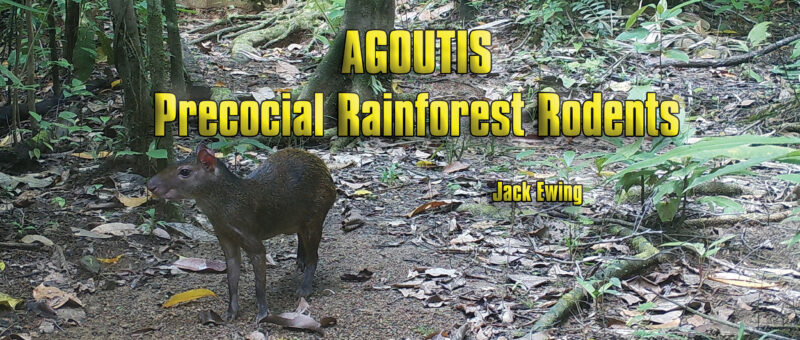Agoutis: Precocial Rainforest Rodents
William Faulkner once said of Ernest Hemmingway: “He has never been known to use a word that might send a reader to the dictionary”. Though I certainly don’t pretend to place myself in the same class as Hemmingway, I readily admit that the same criticism could be leveled against my writings. I try to use words that people use in everyday conversation, not words that will send you to a dictionary. But here I am going to make an exception. I’m sure that many readers have never heard the word precocial, or its opposite, altricial. Most farm animals are precocial like a colt, lamb, or a calf for example. All of these are born with their eyes open and can stand, nurse, and follow its mother shortly after birth. Puppies and kittens are altricial, born with their eyes and ears closed and helpless for days after birth. Most rodents are altricial, but agoutis are an exception to that rule, being the only precocial rodent I know of, though there are likely some that I don’t know of.
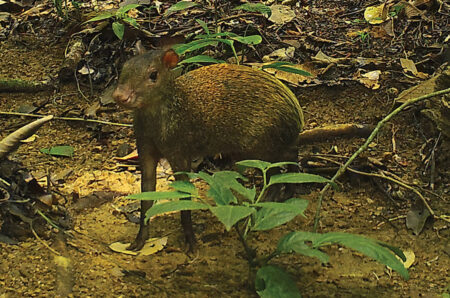 Biologists often compare agoutis, who are diurnal, to their larger nocturnal cousins, the pacas, and often to rabbits, excepting the long ears. Agoutis hop like a rabbit when startled, and even when not startled they are impressive jumpers. I once set a trail camera near a pool in hopes of getting a video of otters, which to my delight, came to the pool daily. In addition to the otters, the camera captured many videos of pacas and agoutis, who came to the pool to drink, and several species of wading birds that fed in the shallows. One day a mother caiman moved in with about a dozen babies. None of the wading birds would go near the water, and the two mammals kept their distance. One brave agouti walked to within a meter of the pool, which was about two meters wide, leaped high in the air and all the way across the water, landing safely on the other side, a jump of about three meters (almost 10 feet). I’m not sure a rabbit could jump that far.
Biologists often compare agoutis, who are diurnal, to their larger nocturnal cousins, the pacas, and often to rabbits, excepting the long ears. Agoutis hop like a rabbit when startled, and even when not startled they are impressive jumpers. I once set a trail camera near a pool in hopes of getting a video of otters, which to my delight, came to the pool daily. In addition to the otters, the camera captured many videos of pacas and agoutis, who came to the pool to drink, and several species of wading birds that fed in the shallows. One day a mother caiman moved in with about a dozen babies. None of the wading birds would go near the water, and the two mammals kept their distance. One brave agouti walked to within a meter of the pool, which was about two meters wide, leaped high in the air and all the way across the water, landing safely on the other side, a jump of about three meters (almost 10 feet). I’m not sure a rabbit could jump that far.
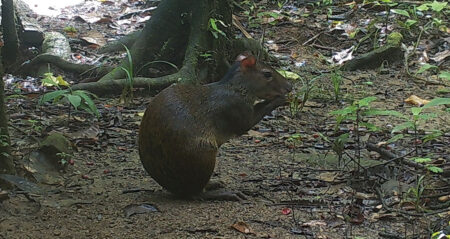 When I see an agouti, I am reminded of a big, tailless squirrel. Look at the photos and decide for yourself whether they look more like rabbits or squirrels. Agoutis are shaped much like a squirrel and have many of the same mannerisms, like standing on their haunches and eating a seed held between the front paws. The Central American Agouti (Dasyprocta punctata), which we have in Costa Rica, is terrestrial, but there are several species in South America which climb trees. Agoutis bury seeds in times of plenty, and dig them up when food is scarce, just like squirrels. However, none of the above-mentioned species are precocial.
When I see an agouti, I am reminded of a big, tailless squirrel. Look at the photos and decide for yourself whether they look more like rabbits or squirrels. Agoutis are shaped much like a squirrel and have many of the same mannerisms, like standing on their haunches and eating a seed held between the front paws. The Central American Agouti (Dasyprocta punctata), which we have in Costa Rica, is terrestrial, but there are several species in South America which climb trees. Agoutis bury seeds in times of plenty, and dig them up when food is scarce, just like squirrels. However, none of the above-mentioned species are precocial.
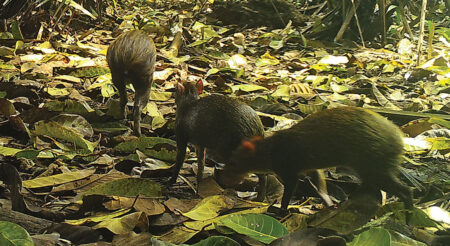 Female agoutis give birth in their own den, but the next day the babies walk along with her for the specific purpose of selecting a den of their own. She shows them several possible sites, which she has scouted out previously, but the day-old young ones make the choice. Whether it be a hollow in a log, a tangle of roots, or a hole in the ground, the entrance must be too small for a coati, jaguarundi, tyra, ocelot, or other predator to enter, and of course, it is too small for the mother. When it is time to nurse, she comes to the opening of the baby’s den, and calls them outside to nurse. At the same time, they urinate and defecate, and the mother eats the droppings so that the odor won’t attract creatures like the spiny-tailed iguanas that might harm the little ones. Though they continue to use their den for a couple of months, until they get too big to fit inside, the young agoutis start following mom around less than a month after birth. This gives her a chance to teach them the basics of survival. I have trail camera photos of three agoutis, two slightly smaller than the third, which I assume is a mother and two nearly grown youngsters. But usually, the mother sends them out into the cruel world to fend for themselves at a younger age. The more plentiful the food, the longer she keeps them under her wing. In times of scarcity, she gives them the boot shortly after they leave the den. Only one in three lives to adulthood. Natural selection takes a heavy toll on agoutis.
Female agoutis give birth in their own den, but the next day the babies walk along with her for the specific purpose of selecting a den of their own. She shows them several possible sites, which she has scouted out previously, but the day-old young ones make the choice. Whether it be a hollow in a log, a tangle of roots, or a hole in the ground, the entrance must be too small for a coati, jaguarundi, tyra, ocelot, or other predator to enter, and of course, it is too small for the mother. When it is time to nurse, she comes to the opening of the baby’s den, and calls them outside to nurse. At the same time, they urinate and defecate, and the mother eats the droppings so that the odor won’t attract creatures like the spiny-tailed iguanas that might harm the little ones. Though they continue to use their den for a couple of months, until they get too big to fit inside, the young agoutis start following mom around less than a month after birth. This gives her a chance to teach them the basics of survival. I have trail camera photos of three agoutis, two slightly smaller than the third, which I assume is a mother and two nearly grown youngsters. But usually, the mother sends them out into the cruel world to fend for themselves at a younger age. The more plentiful the food, the longer she keeps them under her wing. In times of scarcity, she gives them the boot shortly after they leave the den. Only one in three lives to adulthood. Natural selection takes a heavy toll on agoutis.
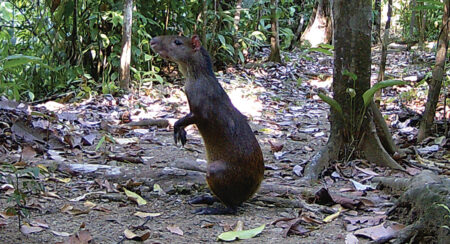 The male and female share a territory but are seldom seen together. When mating time comes around the male pursues the female biting her, jumping into the air, and doing his best to pee all over her. Once he accomplishes this latter feat, she goes into a wild frenzied dance after which she allows him to mate.
The male and female share a territory but are seldom seen together. When mating time comes around the male pursues the female biting her, jumping into the air, and doing his best to pee all over her. Once he accomplishes this latter feat, she goes into a wild frenzied dance after which she allows him to mate.
Years ago, when hunting was rampant, agoutis were seldom seen. Today they are one of the most often sighted mammals on Hacienda Barú Nacional Wildlife Refuge. I thoroughly enjoy seeing them and observing their behavior.

